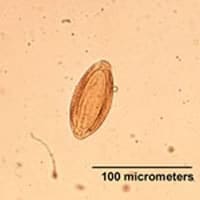
Monthy Case Studies - 2001
Case #52 - January, 2001
A small group of military cadets conducted survival training in Central America for one week during the summer. They were not given any food or water and were instructed to make use of the resources available in the wilderness. Two months after the exercise, one cadet went to the infirmary complaining of sharp abdominal pain that he had been experiencing for about two weeks. The cadet recalled eating various insects, including beetles, during the survival training. He also remembered seeing a small pig farm approximately 30 miles from where they were camped. The physician ordered an ova and parasites (O & P) stool examination. Objects, like the one in Figure A, were seen in low numbers. What is your diagnosis? Based on what criteria?

Figure A
Answer to Case #52
This was a case of acanthocephaliasis, most likely cased by Macracanthorhynchus hirudinaceous, commonly found in pigs. Diagnostic features observed were:
- the shape of the egg, which was very elongate and ovoid or ellipsoidal.
- an egg within the size range for Macracanthorhynchus hirudinaceous (80 to 100 by 40 to 50 micrometers).
- three membranes visible in the egg: a thin outer membrane, a thick, bile-stained shell, and an inner fertilization membrane.
- the presence of an embryo in the egg (sometimes referred to as an "acanthor"). In some eggs, though not clearly shown in the image provided, you can see the hooks on the anterior end of the acanthor.
More on: Acanthocephaliasis
Images presented in the monthly case studies are from specimens submitted for diagnosis or archiving. On rare occasions, clinical histories given may be partly fictitious.
 ShareCompartir
ShareCompartir


